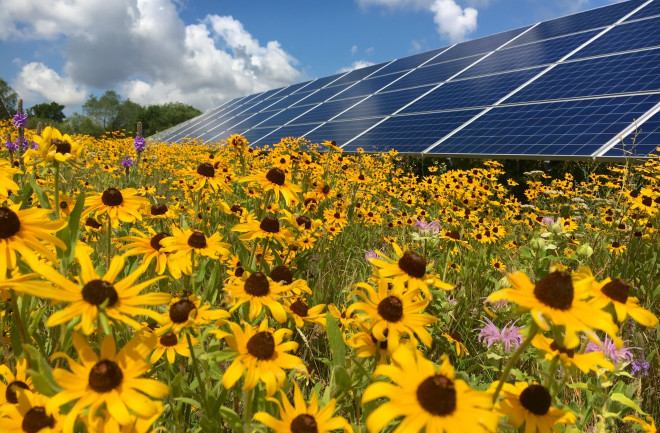
The report provides new best practice guidelines on improving biodiversity of solar farms. Image: Solar Energy UK.
Solar farms can help reverse Britain’s declining wildlife through animal habitat enhancements, a new report from Solar Energy UK has detailed.
Pointing to research that shows 60% of British wildlife species monitored have declined since 2019 while 15% are facing extinction due to factors including habitat loss and pesticides, the report – which offers best practice guidance – highlighted how solar farms can help land recover from intensive farming and enable the natural environment to flourish.
For solar farms on previously arable land, giving this land a break from intensive cultivation can boost biodiversity, soil health and regeneration.
As less than 2% of land is disturbed by infrastructure, the remainder of a site can then be set aside for grassland and wildflower meadows, which provide habitats for pollinators, birds and other wildlife as well as potentially sheep grazing, helping to contribute to food production.
Indeed, research from Lancaster University released at the end of last year found that changes to how solar PV land in the UK is managed could see sites support four times as many bumble bees.
Easy, cost-effective biodiversity improvements identified in the report include:
- Seeding a diverse wildflower and grass mix over all or part of a site
- Hedgerow planting and management around the boundary, including filling in gaps of existing hedgerows or planting new hedgerows to join up existing hedgerows
- The creation of ponds, scrapes and other wetland features in low-lying corners
- Providing habitats for specific species such as hibernacula for reptiles and amphibians as well as bird and bat boxes
The potential for biodiversity improvements does vary from site to site, however, due to soil types, topography and climate.
Aspirations of boosting natural capital on solar farms is now legally underpinned by the Environment Act 2021, which requires every new Town and County Planning Act development in England to deliver a measurable biodiversity net gain of 10% from November 2023.
The report from Solar Energy UK – which saw contributions from other organisations including Wychwood Biodiversity, Eden Renewables, NextEnergy and Natural Power – identified several key learnings.
One of these was around mitigation of negative impacts on the site, with the report producing a mitigation hierarchy from most desirable to least desirable.
The most desirable situation would be to avoid negative impacts, followed by mitigating impacts if they can’t be avoided and rectifying or restoring any impacts, with the least desirable being to offset or compensate the losses elsewhere if all avoidance, mitigating and rectification steps have been taken but impacts remain.
Other key learnings included the importance of consistency of key documents throughout the project,effective monitoring and communication of data, as well as all consultants involved in a project and the developer fully understanding the cost implications of their recommended natural capital prescriptions.
The report also have several examples of solar farms, including the 6.6MW Sawmills solar farm, which was developed by Eden Renewables and is operated by Belltown Power and owned by Foresight Solar Fund, that have already taken steps to enhance habitats.
This Sawmills site for example, was designed to promote biodiversity, including providing habitats for declining species such as the rare cirl bunting.
Wychwood Biodiversity advised on ecological enhancements and carried out annual monitoring from 2015 to 2021, which focused on three indicator groups, including the number of species of breeding birds on site.
The results from this have seen overall gains in all three groups, with the most recent surveys in April to July 2021 showing the highest botanical diversity recorded to date, which the report said in turn is likely to have influenced the highest invertebrate diversity and abundance.
Seven bird species of conservation concern were observed, including the cirl bunting which has been seen several times on site during breeding bird surveys.
Sister publication PV Tech Power recently spoke to Wychwood Biodiversity’s founder and co-director Guy Parker as part of a wide-ranging feature on boosting the biodiversity and wildlife habitats of solar farms.
"Ultimately, to encourage biodiversity on a solar farm, you need a willing project owner, a sensible biodiversity management plan, a diversity of habitats and consistency in management to enable wildlife to flourish," Parker told PV Tech Power.
